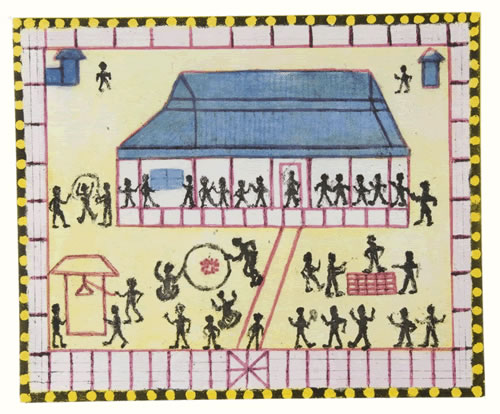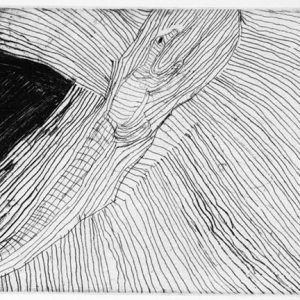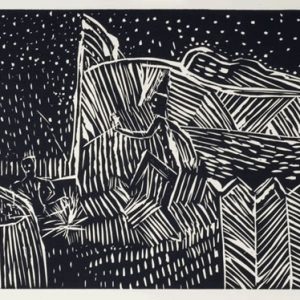Description
This image is from an exhibition of intimate memory pictures which detail the experiences and locations central to Roy Kennedy (Wirradjuri) and Jim Stanley (Kamilaroi. Kennedy grew up at Warangesda Station near present day Griffith, while Stanley grew up at the Moree Station. Both artists situate their paintings resolutely within the institutional confines of mission and reserve life.
Roy Kennedy has said that his work depicts- the place of my mother’s birth, also my birth. This is the mission I was brought up on. This shows my memories of childhood days. Warangesda Mission up top and the Police Paddock Mission down the bottom
Rather than his more favoured medium of etching where surfaces and marks can be built up, erased and shifted in the printmaking process, there is a sensual immediacy and directness to the paintings that marks a significant formal shift in Roy Kennedy’s practice. Working in pen and ink on a wash ground Kennedy has developed a complex and intriguing set of repeat motifs. The Murrumbidgee River it’s billabongs and tributaries is always a key presence. The river frames the activities and structures of the Warangesda site. While not listing all of them, the motifs include the football field, the bridge, the flowering mulberry tree and various animals. Then there are the fences and gates, the clothes lines, sheds and outhouses, the bore tank and taps. Situated somewhere in each composition is the police station, sometimes there is the Point Hotel. And in amongst these things there are people. There are significant discrepancies in scale of the motifs which adds a dynamism to the compositions. The wash grounds give not only a formal unity but another sense of flow to the images. Roy Kennedy depicts an energetic and sometimes unnerving combination of the archaic and the modern, the natural and the built environments.
There is a similar sense of the old and new in an article of the Northwest Champion of 1953- The Moree Station is situated a little over two miles west of the town on the left bank of the Mehi on a patch of red soil, much more suitable for building purposes than the surrounding black soil… A fairly well gravelled road connects the settlement with the town, and although it is situated quite close to the river, it is above ordinary flood level…The Board provides at the Moree Station as at all of its other stations of a similar size, a Managers residence and office, a Welfare Officer’s residence and a school teachers residence. All these cottages are of a reasonable size and comfortable, with the usual country town conveniences with electric light and water laid on. For the dark population 24 new cottages have recently been completed. Nineteen of the cottages in addition to the usual offices with generous cupboard spaces provided, have three bedrooms each. Five cottages of a similar design, neat and attractive, have two bedrooms each. There are seven old cottages also of three and four rooms each. These old buildings are to be shifted and made more homelike and attractive…
This site is an important part of the world that Jim Stanley paints. Although there are some works in the permanent collection of the Moree Plains Regional Gallery until this exhibition Stanley s work has not been seen outside his home town. The representations of his memories and experiences growing up in Moree are carefully structured and composed miniatures. There is a formal rigour in the combination of biro and paint dots and marks. Stanley paints meticulously detailed views of the Top Camp, the school house, cooking and fishing scenes, ceremonies and special places along the Mehi River. In one of the larger works there are two trees, one with marked with a diamond shape the other with a possum totem. To completely fix his memories in place Stanley uses text as key element of the image. This diaristic element gives another level of intensity to the works. The insistent labelling reiterates the importance of family and community. The smaller paintings are not only more intimate in scale but also in content for example-Hospital Ward in Moree Where I Was Born On 8/31927 With Yellow Veil Over My Face With Birth Marks (2004) or Three Guardian Spirits Pulling Me From a Lagoon I Was Drowning (2004).
Roy Kennedy and Jim Stanley paint pictures of home. Before the digital age and even now, most children do not know anything about their world except for their immediate environment and what happens there. These patterns of dailiness and awareness of location are the beginnings of the self.
Kennedy and Stanley’s images are perhaps at odds with the common view of the history and development of state run missions and reserves for Aboriginal peoples in New South Wales. This history states that during the nineteenth century a combination of the inexorable growth of the pastoral industry and the influx of Europeans with the gold rushes led to the displacement of and concentration of aborigines in Reserves and Missions around New South Wales. In order to control and monitor these reserves and missions the Aboriginal Protection Board was established by the New South Wales government in 1883. By the beginning of the twentieth century many more Indigenous communities had moved to the reserves on the outskirts of country towns as the larger pastoral holdings were split up into smaller and smaller properties. This process reduced the potential of living from the land and as well as limiting employment opportunities for Aboriginal people on those properties. Being close to town at least offered a meagre possibility of paid work. By 1945 there were over 100 reserves in New South Wales under the aegis of the newly named Aboriginal Welfare Board. The terrible stories of poor management and inhumane conditions on the Reserves, the policy of forced removal of children from families, the realities and effects of the colour bar in NSW towns are now well known.
However in recent years there has been an important reconfiguration of the experiences of mission and reserve life. As Francis Peters-Little has written- For many Aboriginal elders, their illustrations of mission, reserve and pastoral life are neither simply negative nor romantic. It becomes clear when talking to them that missions and reserves have become as vital to their identity as sacred sites and ceremonies of significance; their generation recalls the days where proper values’s were kept. This is more significant and relevant to them than the way white historians have spoken about reserves and missions&. Memories of their ability to resist are more significant than the oppression they endured&.. Their identities were rooted in their ability to survive mission and station life, as opposed to identifying with a traditional life, history, site and experience denied to them. The hardship they endured has since become almost an accepted part of aboriginality
In many communities around New South Wales such reflections and memories of Station and Reserve life are becoming more public. For example in Moree, Jim Stanley’s home town, Noeline Briggs Smith has authored two important works. Winanga Li and Burrul Wallaay that restore these knowledges. Briggs-Smith is also one of many people making Aborigine’s genealogy more accessible.
This exhibition of the work of Roy Kennedy and Jim Stanley is also a key part of this process of bringing to knowledge and celebration.
Craig Judd
February 2004
© 2003-2007 Neil Murphy Indigenous Art




